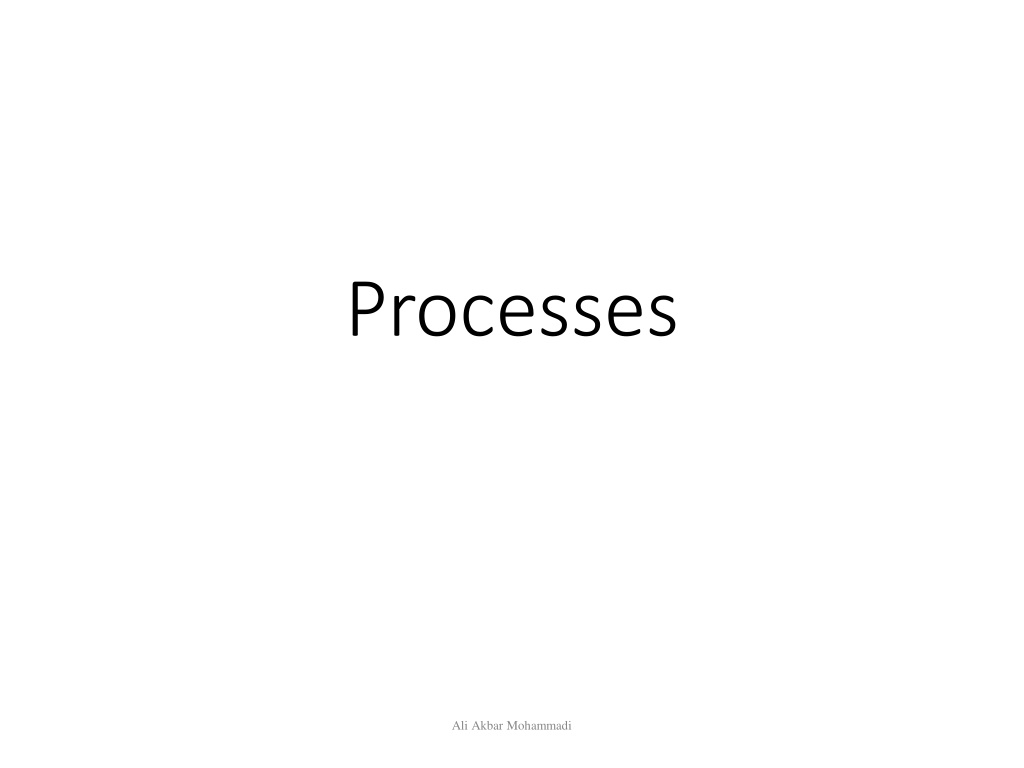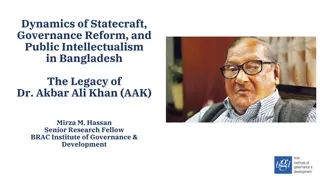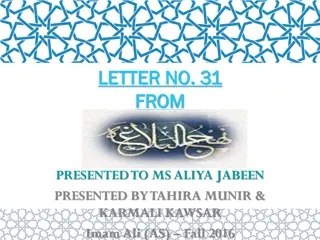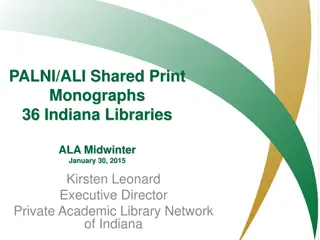Understanding Processes and Process Management Theory by Ali Akbar Mohammadi
Delve into the intriguing world of processes, process scheduling, and process control in operating systems through the detailed insights provided by Ali Akbar Mohammadi. Explore key concepts such as process states, process control blocks, CPU switching, and context switching to enhance your understanding of process management theory.
Download Presentation

Please find below an Image/Link to download the presentation.
The content on the website is provided AS IS for your information and personal use only. It may not be sold, licensed, or shared on other websites without obtaining consent from the author. Download presentation by click this link. If you encounter any issues during the download, it is possible that the publisher has removed the file from their server.
E N D
Presentation Transcript
Processes Ali Akbar Mohammadi
Processes Process Concept Process Scheduling Operations on Processes Interprocess Communication Ali Akbar Mohammadi 2
Process Concept Ali Akbar Mohammadi
Process Concept An operating system executes a variety of programs: Batch system jobs Time-shared systems user programs or tasks Textbook uses the terms job and process almost interchangeably Process a program in execution; process execution must progress in sequential fashion A process includes: program counter and process registers stack and heap text section data section Ali Akbar Mohammadi 4
Process in Memory Ali Akbar Mohammadi 5
Process State As a process executes, it changes state new: The process is being created running: Instructions are being executed waiting: The process is waiting for some event to occur (such as an I/O completion or reception of a signal) ready: The process is waiting to be assigned to a processor terminated: The process has finished execution Ali Akbar Mohammadi 6
Process Control Block (PCB) Information associated with each process Process state Program counter CPU registers CPU scheduling information Memory-management information Accounting information I/O status information Ali Akbar Mohammadi 7
CPU Switch From Process to Process Ali Akbar Mohammadi 8
Context Switch When CPU switches to another process (because of an interrupt), the system must save the state of the old process and load the saved state for the new process Context-switch time is overhead; the system does no useful work while switching Time dependent on hardware support Ali Akbar Mohammadi 9
Process Scheduling Ali Akbar Mohammadi
Process Scheduling Queues Job queue set of all processes in the system Ready queue set of all processes residing in main memory, ready and waiting to execute Device queues set of processes waiting for an I/O device Processes migrate among the various queues Ali Akbar Mohammadi 11
Ready Queue And Various I/O Device Queues Ali Akbar Mohammadi 12
Representation of Process Scheduling An interrupt occurs Ali Akbar Mohammadi 13
Schedulers Long-term scheduler (or job scheduler) selects which processes should be brought into the ready queue Short-term scheduler (or CPU scheduler) selects which process should be executed next and allocates CPU Ali Akbar Mohammadi 14
Schedulers (Cont.) Short-term scheduler is invoked very frequently (milliseconds) (must be fast) Long-term scheduler is invoked very infrequently (seconds, minutes) (may be slow) The long-term scheduler controls the degree of multiprogramming Processes can be described as either: I/O-bound process spends more time doing I/O than computations, many short CPU bursts CPU-bound process spends more time doing computations; few very long CPU bursts Some systems have no long-term scheduler Every new process is loaded into memory System stability effected by physical limitation and self-adjusting nature of the human user Ali Akbar Mohammadi 15
Operations on Processes Ali Akbar Mohammadi
Process Creation Parent process creates children processes, which, in turn create other processes, forming a tree of processes Resource sharing options Parent and children share all resources Children share subset of parent s resources Parent and child share no resources Execution options Parent and children execute concurrently Parent waits until some or all of its children have terminated Ali Akbar Mohammadi 17
Process Creation (Cont.) Address space options Child process is a duplicate of the parent process (same program and data) Child process has a new program loaded into it UNIX example fork() system call creates a new process exec() system call used after a fork() to replace the memory space of the process with a new program Ali Akbar Mohammadi 18
Process Tree on a typical Solaris System Ali Akbar Mohammadi 19
C Program Forking Separate Process int main(void) { pid_t processID; processID = fork(); // Create a process if (processID < 0) { // Error occurred fprintf(stderr, "Fork failed"); exit(-1); } // End if else if (processID == 0) { // Inside the child process (no execlp() this time) printf ("(Child) I am doing something"); } // End else if else { // Inside the parent process printf("(Parent) I am waiting for PID#%d to finish\n", processID); wait(NULL); printf ("\n(Parent) I have finished waiting; the child is done"); exit(0); } // End else return 0; } // End main Ali Akbar Mohammadi 20
Process Creation Ali Akbar Mohammadi 21
Process Termination Process executes last statement and asks the operating system to terminate it (via exit) Exit (or return) status value from child is received by the parent (via wait()) Process resources are deallocated by operating system Parent may terminate execution of children processes (kill() function) Child has exceeded allocated resources Task assigned to child is no longer required If parent is exiting Some operating system do not allow child to continue if its parent terminates All children terminated - cascading termination Ali Akbar Mohammadi 22
Interprocess Communication Ali Akbar Mohammadi
Cooperating Processes An independent process is one that cannot affect or be affected by the execution of another process A cooperating process can affect or be affected by the execution of another process in the system Advantages of process cooperation Information sharing (of the same piece of data) Computation speed-up (break a task into smaller subtasks) Modularity (dividing up the system functions) Convenience (to do multiple tasks simultaneously) Two fundamental models of interprocess communication Shared memory (a region of memory is shared) Message passing (exchange of messages between processes) Ali Akbar Mohammadi 24
Communications Models Shared memory Message passing Ali Akbar Mohammadi 25
Shared Memory Systems Shared memory requires communicating processes to establish a region of shared memory Information is exchanged by reading and writing data in the shared memory A common paradigm for cooperating processes is the producer-consumer problem A producer process produces information that is consumed by a consumer process unbounded-buffer places no practical limit on the size of the buffer bounded-buffer assumes that there is a fixed buffer size Ali Akbar Mohammadi 26
Message-Passing Systems Mechanism to allow processes to communicate and to synchronize their actions No address space needs to be shared; this is particularly useful in a distributed processing environment (e.g., a chat program) Message-passing facility provides two operations: send(message) message size can be fixed or variable receive(message) If P and Q wish to communicate, they need to: establish a communicationlink between them exchange messages via send/receive Logical implementation of communication link Direct or indirect communication Synchronous or asynchronous communication Automatic or explicit buffering Ali Akbar Mohammadi 27
Direct Communication Processes must name each other explicitly: send (P, message) send a message to process P receive(Q, message) receive a message from process Q Properties of communication link Links are established automatically between every pair of processes that want to communicate A link is associated with exactly one pair of communicating processes Between each pair there exists exactly one link The link may be unidirectional, but is usually bi-directional Disadvantages Limited modularity of the resulting process definitions Hard-coding of identifiers are less desirable than indirection techniques Ali Akbar Mohammadi 29
Indirect Communication Messages are directed and received from mailboxes (also referred to as ports) Each mailbox has a unique id Processes can communicate only if they share a mailbox send(A, message) send message to mailbox A receive(A, message) receive message from mailbox A Properties of communication link Link is established between a pair of processes only if both have a shared mailbox A link may be associated with more than two processes Between each pair of processes, there may be many different links, with each link corresponding to one mailbox Ali Akbar Mohammadi 30
Indirect Communication (continued) For a shared mailbox, messages are received based on the following methods: Allow a link to be associated with at most two processes Allow at most one process at a time to execute a receive() operation Allow the system to select arbitrarily which process will receive the message (e.g., a round robin approach) Mechanisms provided by the operating system Create a new mailbox Send and receive messages through the mailbox Destroy a mailbox Ali Akbar Mohammadi 31
Synchronization Message passing may be either blocking or non-blocking Blocking is considered synchronous Blocking send has the sender block until the message is received Blocking receive has the receiver block until a message is available Non-blocking is considered asynchronous Non-blocking send has the sender send the message and continue Non-blocking receive has the receiver receive a valid message or null When both send() and receive() are blocking, we have a rendezvous between the sender and the receiver Ali Akbar Mohammadi 32
Buffering Whether communication is direct or indirect, messages exchanged by communicating processes reside in a temporary queue These queues can be implemented in three ways: 1. Zero capacity the queue has a maximum length of zero - Sender must block until the recipient receives the message 2. Bounded capacity the queue has a finite length of n - Sender must wait if queue is full 3. Unbounded capacity the queue length is unlimited Sender never blocks Ali Akbar Mohammadi 33
Source: Operating System Concepts 7th edition, Jan 19, 2005 Silberschatz, Galvin and Gagne Chapter 3: processes Ali Akbar Mohammadi























